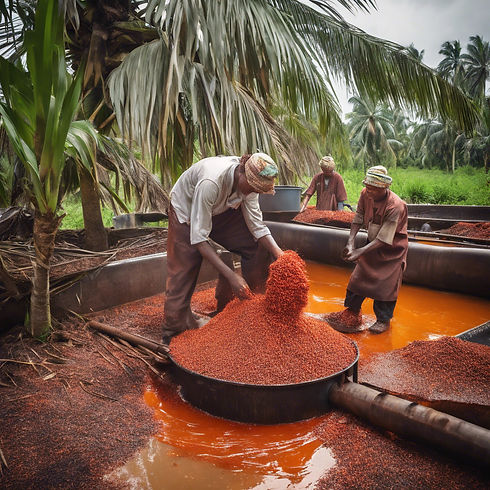
Crude palm oil
The crude palm oil processing industry is essential in providing a major source of edible oil globally. It involves extracting oil from oil palm fruit and refining it for various applications, including food and cosmetics. As demand rises, the industry faces sustainability challenges, leading to efforts for responsible sourcing and improved practices.
Types of Palm tree and oil
Tenera :
A hybrid of Dura and Pisifera species, produces larger, thinner fruit with a larger mesocarp, resulting in higher oil yield per hectare.


DxP :
A hybrid combining the best features of both palms, is widely grown in the palm oil industry due to its higher oil content per fruit.


Palm oil
Crude palm oil :
It's also known as Red Palm Oil, is produced during mesocarp extraction, containing high vitamin E and carotene content. Its balanced fatty acid composition makes it suitable for consumer products.

Palm kernel oil : Palm kernel oil (PKO) is transparent due to low vitamin E and carotene content, with 80% saturated and 20% unsaturated fatty acids. PKO is used for non-consumable derivatives like detergents and soap.

Extracting crude palm oil
Processing of palm oil :
Refined Bleached deodorized Palm Oil (RBDPO) is a highly processed form of palm oil that undergoes several steps to ensure its purity and quality. The processing begins with the extraction of crude palm oil, which is then refined to remove impurities and free fatty acids. Following refinement, the oil is bleached to eliminate color and deodorized to remove any unwanted odors, resulting in a neutral-tasting oil.

Steps
Physical refining process
The physical refining process on CPO aims to eliminate FFA, colour, and odour from oil. However, high temperatures and vacuum pressure may cause polymerisation and isomerisation reactions, potentially lowering oil quality. Pre-treatment (degumming) and bleaching are performed to minimize these effects.
Degumming
The process involves binding gum and impurities in CPO, removing contaminants like phospholipids and phosphatides. Phosphoric acid is added to bind contaminants, reducing shelf life and causing undesirable flavors. The process involves homogenizing the mixture in a centrifugal stirrer tank. The more gum removed, the lower the gum content.
Bleaching
The bleaching process involves adsorption with a bleaching agent (adsorbent) like bleaching soil, activated clay, or activated charcoal to remove color pigments, gums, moisture, oxidative materials, and trace metals. The adsorbent, activated clay, has the ability to bleach due to its Al3+ ions. The process is conducted at 115-120 C to decrease viscosity and speed up adsorption, and at vacuum pressure to reduce oxidizing agents and water content.
Filtration
Niagara filter is used with a semipermeable membrane. Oil is collected in the oil collector pipe, while wasted soil adheres to the filter's surface. The process requires a temperature between 80 and 120 degrees Celsius.
Deodorizing
Steam distillation removes volatile components from oil, such as aldehydes and ketones, causing off-flavors and odours. This process is carried out under high vacuum and high temperature, resulting in refined oil with no taste or odour. Deodorisation removes trace contaminants and free fatty acids, resulting in refined oil without any odor or taste. The stripping agent stops hydrolysis and helps evaporate volatile components.

Use of palm oil
Based on the end product, the overall use of palm oil may be divided into three categories, which are as follows:
1.Food Items : Over two-thirds (68%) of palm oil is used in culinary items such cooking oil, margarine, chocolate, pizza, and bread.
2.Industrial Goods : Consumer and commercial goods like soap, detergent, cosmetics, and cleaning supplies use 27% of palm oil.
3.Bio-energy : The remaining 5% is utilised as biodiesel, which is utilised as fuel for heating, power generation, and transportation.

Challenges of the Industry in
Indonesia
Companies in Indonesia
PT SMART tbk

They operates 134,000 hectares of oil palm crops, primarily for planting and harvesting, and trading palm oil-based goods globally. They also operate 16 mills, 4 refineries, and 4 palm kernel processing facilities.
PT Astra Agro Lestari Tbk

The company manages 297,011 hectares in South Kalimantan and Sulawesi, with 31 processing plants, two refineries, and 14 kemel crusher machines, producing 1,510 tonnes of TBS per hour.
PT Salim Ivomas pramata

The Plantation Division's core planted area covers 293,429 hectares, with 83% oil palm, 6% rubber, and 5% sugar cane. Other crops include cocoa, tea, and industrial tree plantations. Producing 7.2 million tons per year of CPO.







